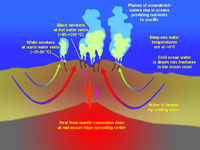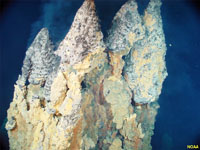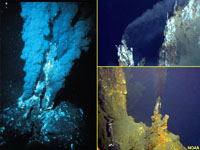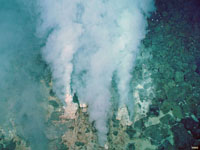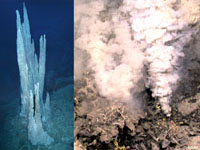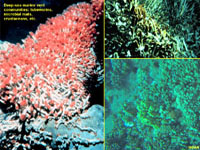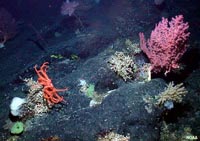5.12: Vents on the Seafloor- Black Smokers, White Smokers, and Deep-Sea Vent Communities
- Page ID
- 9900
Vents on the Seafloor: Black Smokers, White Smokers, and Deep-Sea Vent Communities
Hydrothermal vents form where there is volcanic activity on or below the ocean floor, such as along the Mid-Ocean Ridge. Water seeps through cracks in the seafloor and is heated by hot rock deep below the ocean crust to as high as 400°C. This hot water is under too much pressure to boil, but it erupts as “smoky fountains” at vents on the sea floor. The hottest vent produce unusual chimney-like towers called "black smokers." The hot water contains dissolved metals (including iron, manganese, zinc, copper, sulfur, and others). When they encounter the cold ocean water, the minerals precipitate, making dark plumes of water and irregular deposits (including “chimneys”) on the seabed. The rich supply of nutrients support chemotrophic bacteria (feeding on sulfur compounds) that support a complete food web of seafloor creatures, including tube worms, arthropods, fish, and other benthic life forms adapted to these harsh and temporary environments.
Cooler vents produce “white smokers” that are dominated by deposits of calcium-rich minerals, including anhydrite gypsum (CaSO4) and calcite (CaCO3). Minerals in ocean crustal rocks are rich in calcium, which dissolves easily on cold seawater. Where the warmed seawater rises back to the surface, the calcium-enriched water produces “white smokers” along with deposits of minerals that also host deep-sea bed communities.
Deep sea vents have been identified in many locations along mid-ocean ridges and along the flanks of undersea volcanoes. Current thought is that many of the major economic mineral deposits of the world may be associated with ancient deep-sea vent deposits.



